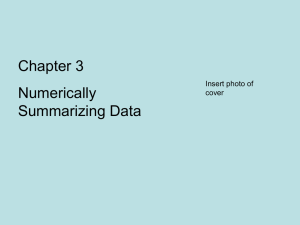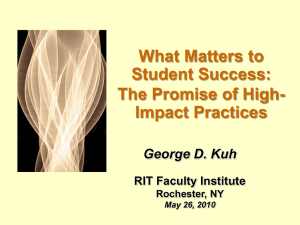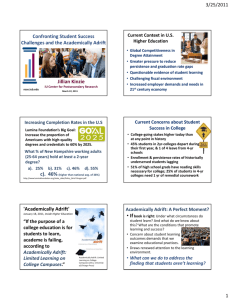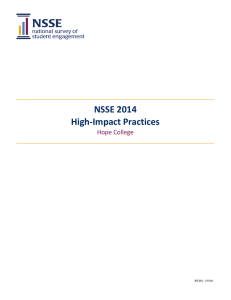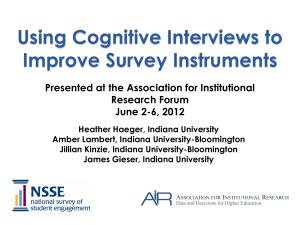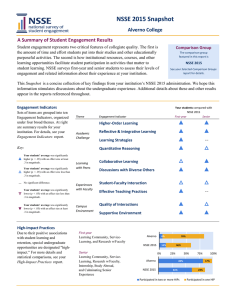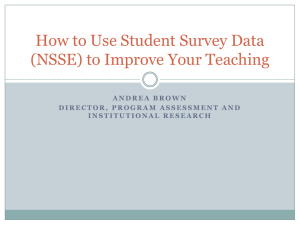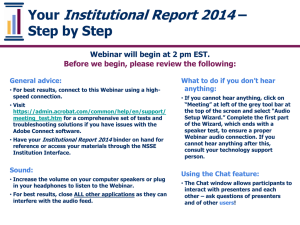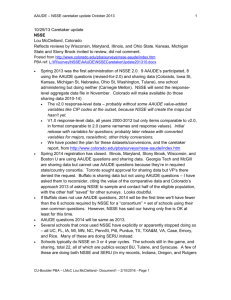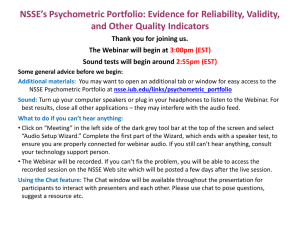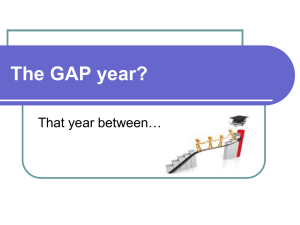Assessing Student Engagement in High-Impact Practices
advertisement
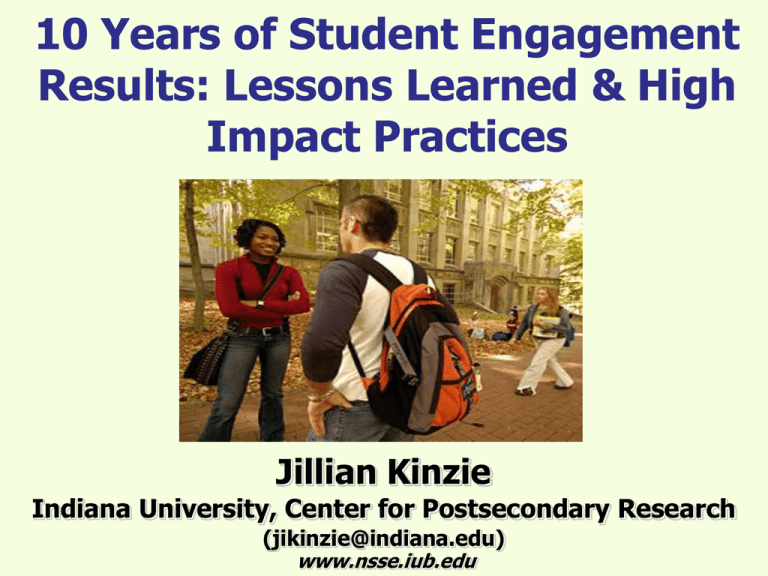
10 Years of Student Engagement Results: Lessons Learned & High Impact Practices Jillian Kinzie Indiana University, Center for Postsecondary Research (jikinzie@indiana.edu) www.nsse.iub.edu The NSSE Project • Assessment tool provides institutions with data about student engagement in educational practices that research correlates with student learning & success • NSSE results are immediately actionable institutions can use information to pinpoint strengths & identify areas for improvement • Results useful for research and to guide educational practice What we’ve learned from NSSE - 1 1. Student learning and personal development are enhanced when students engage in educationally purposeful activities. 2. The single best predictor of student satisfaction with college is the degree to which they perceive the college environment to be supportive of their academic and social needs. What we’ve learned from NSSE - 2 3. Student engagement positively related to student grades and to persistence for all students. 4. At institutions where faculty members use effective educational practices more frequently in their classes, students are more engaged over all and gain more from college. Findings about FSSE and student engagement 1. When faculty members emphasize certain educational practices, students engage in them to a greater extent than their peers elsewhere. 2. Good things go together. Percentage of Seniors Who Did the Experience Senior Students Participation in ‘High Impact Activities’ 50% Culminating Senior Experience Research with a Faculty Member 40% Study Abroad 30% 20% 10% 0% Somewhat Important Important Very Important Average Importance Faculty Placed on the Experience Lessons about Effective Educational Practices 1. Engagement benefits all students – but, some students benefit more. 2. Deep approaches to learning are worth fostering. 3. Some educational activities – “High Impact Practices” - have greater impact on student learning than others. Engagement is positively related to grades, retention for all students, but some students – those entering with low ACT scores and historically underrepresented students – appear to benefit more than others from the same educational programs or practices. Effect of Engagement on GPA by ACT scores Deep Approaches to Learning: The kind of learning we want for all students • From AAC&U: We “hope for students to engage intellectually and seriously with what is taught… [leading to] deep learning …the ability to defend positions…write well and think clearly… to develop rational and reflective minds, open to continuous learning…” (Greater Expectations pp. 8-9) NSSE Deep Approaches to Learning Scales Deep approaches to learning Higher order thinking (item 2b,c,d,e) Integrated learning (items 1d,e,i,p,t) Reflective learning (items 6d,e,f) • Educationally substantive information, interesting to faculty • Perform well in analyses NSSE Deep/Integrative Learning Integrating ideas or information from various sources Included diverse perspectives in class discussions/writing Put together ideas from different courses Discussed ideas with faculty members outside of class Discussed ideas with others outside of class Analyzing the basic elements of an idea, experience, or theory Synthesizing & organizing ideas, info., or experiences Making judgments about the value of information Applying theories to practical problems or in new situations Examined the strengths and weaknesses of your own views Tried to better understand someone else's views Learned something that changed how you understand an issue Findings about NSSE Deep Approaches to Learning & Student Outcomes • Increased participation in deep approaches is associated with elevated levels of engagement in other areas, including enriching educational experiences, time spent preparing for class etc. • Strong relationship between deep approaches and self-reported gains in intellectual and social development High-Impact Practices Educational experiences that make a significant difference to student persistence, learning outcomes, and student success. 1. Pedagogical practices for all classrooms 2. Structural features High Impact Pedagogical Practices • • • • • • • • • Asked questions in class or contributed to class discussions Made a class presentation Prepared two or more drafts of a paper or assignment Worked with other students on projects during class Worked with classmates outside of class on assignments Tutored or taught other students (paid or voluntary) Participated in a community-based project as part of course Talked about career plans with a faculty member or advisor Discussed ideas from readings/classes with faculty outside class • Received prompt feedback on your academic performance • Worked harder than you thought • Worked with faculty on activities outside coursework (committees, student life, etc.) • Discussed ideas from readings/classes with others • Had serious conversations with students of a different race or ethnicity and those who differ from you - religious beliefs, political opinions, or personal values High Impact Activities First-Year Seminars and Experiences Common Intellectual Experiences Learning Communities Writing-Intensive Courses Collaborative Assignments and Projects Undergraduate Research Diversity/Global Learning Service Learning, Community-Based Learning Internships Capstone Courses/Projects Highlights: High-Impact Practices in the First Year • Learning communities. Most positive structures include: integrated assignments, activities, or discussion groups; peer mentors; required out-ofclass activities. • First Year Seminar. Research about what works from The National Resource Center for The First-Year Experience and Students in Transition • Service learning. Most beneficial when connected to course; particularly within learning community; most powerful as community-based research. High Impact Activities How many of these activities exist for your students? How widespread are these activities? Which practices would be particularly beneficial to your students? Are these magical practices?? High-Impact Activities Increase Odds Students Will: Invest time and effort Interact with faculty and peers about substantive matters Experience diversity Get more frequent feedback Reflect & integrate learning Discover relevance of learning through real-world applications Do All Students Experience High-Impact Practices? •Nope. High Impact Practices Reach A Fraction of Students • Participation Levels in NSSE cohort: First Year Students: Learning Communities 17% Service Learning 36% Seniors: Research With Faculty 19% Internship 53% Study Abroad 19% (9% FG) First-generation (FG), racial-ethnic, major differences Reactions, Discussion, Questions?? 1. Is your institution focused on these matters? 2. What other effective educational practices are emphasized at your institution? www.nsse.iub.edu Findings from NSSE and AAC&U: Some Educational Activities are Unusually Effective Growing evidence that “high-impact practices” provide substantial educational benefits to students High Impact Activities First-Year Seminars and Experiences Common Intellectual Experiences Learning Communities Writing-Intensive Courses Collaborative Assignments and Projects “Science as Science Is Done”; Undergraduate Research Diversity/Global Learning Service Learning, Community-Based Learning Internships Capstone Courses and Projects Learning More about High Impact Activities Activities collected by NSSE include participation in: • • • • • Learning Communities Service Learning Research with a Faculty Member Study Abroad Culminating Senior Experience NSSE Annual Report 2007 High Impact Practice results Download: www.nsse.iub.edu (“Reports & Services”) Outcomes Associated with High Impact Practices Deep learning: Attend to underlying meaning of information as well as content; Integrate and synthesize ideas, information; Discern patterns in evidence or phenomena; Apply knowledge in different situations; View issues from multiple perspectives Educational Gains: General Education – Writing; speaking clearly; gen ed; critical thinking Practical Competence – Working with others, solving real problems, work related knowledge Personal/Social Development – understanding self; contributing to community; Effects of Participating in High Impact Practices on Deep/Integrative Learning and Gains First-Year Students Learning Communities Deep Learning General Education +++ ++ Seniors Service Learning Study Abroad Senior Capstone +++ ++ ++ ++ + ++ ++ Personal/Social Development ++ +++ Practical Competence ++ ++ + p<.001; ++ p<.001, Unstd B >.10; +++ p<.001, Unstd B >.30 ++ ++ High Impact Activities • All associated with desirable learning and personal development outcomes. • Some features have more impact. • Not all students take part. Learning Communities • Formal program where groups of students (FY) take two or more classes together • NSSE explored different program features of LC’s … • LC programs that integrate material across courses are associated with higher student engagement and learning Learning Community Program Characteristics Integrative course or discussion group Related to academic major Required out-of-class activities Courses closed to LC students Assignments integrate material Undergraduate peer advisors Majority of courses in LC Residential Learning Community (LC) Characteristics and Gains Students who frequently integrate material from LC classes benefitted more in terms of gains, deep approaches to learning, and an enriched social life. Required out-of-class activities were related to gains in self-understanding, deep learning, and an enriched social life. An undergraduate peer advisor is associated with reports of more supportive campus environment and an enriched social life. Living-learning communities linked to the quality of social life, but not other outcomes. Service Learning • Community-based project as part of a regular course • More likely to be present at smaller and private institutions • Positively associated with deep learning and personal development Service Learning • High ACT more likely to do service • Males: “don’t plan to do service.” • Being in a LC most important predictor for FY students’ propensity to volunteer • Education & Business students do more service than others… • Faculty Survey of Student Engagement (FSSE) results show 55% faculty teaching FY think “community service” is “important” but, less than 25% do “service-learning” in their FY courses. Effects of Participating in High Impact Practices on Deep/Integrative Learning and Gains First-Year Learning Communities Seniors Research w/ Faculty Study Abroad Senior Capstone Deep Learning +++ +++ ++ ++ General Education ++ ++ + ++ Personal/Social Development ++ ++ ++ Practical Competence ++ ++ + p<.001; ++ p<.001, Unstd B >.10; +++ p<.001, Unstd B >.30 ++ ++ High-Impact Practices: Research with a Faculty Member • Outside of course or program requirements • More likely at Bac A&S colleges and in the sciences; Less likely in business • Majority utilized existing info (libraries, WWW), and almost half worked in laboratory and fieldwork settings. • Reviewing literature and interpreting findings most closely related to deep learning. Data collection had the weakest relationship. Effects of Participating in High Impact Practices on Deep/Integrative Learning and Gains First-Year Students Learning Communities Deep Learning General Education +++ ++ Seniors Service Learning Study Abroad Senior Capstone +++ ++ ++ ++ + ++ ++ Personal/Social Development ++ +++ Practical Competence ++ ++ + p<.001; ++ p<.001, Unstd B >.10; +++ p<.001, Unstd B >.30 ++ ++ Study Abroad • Students who studied overseas engaged more frequently in educationally purposeful activities afterwards and reported gaining more from college. • Students who lived with host nationals – in home stays or in dorms – benefited more in terms of integrative and reflective learning, and personal and social gains. • The length of time spent overseas did not make a difference in the frequency with which students used deep learning approaches after returning or their selfreported gains. Study Abroad: Implication for Practice • Amount of time abroad not as important as whether student has such an experience. • Value in increasing short-term cross-cultural or “study away”, “May term” opportunities for students who cannot be away from their home institution for extended period of time Culminating Senior Activities • Capstone course, senior project/thesis, comp exam, etc. • Field placements have impact on greatest number of gains, • Also beneficial: – – – – Projects that required the greatest investment of time, Working in groups, Meeting often with supervising faculty member, and Receiving clear expectations for the activity. What is it about these high-impact activities that appear to be so effective with students? Practices Increase Odds That Students Will: Invest time and effort Interact with faculty and peers about substantive matters Experience diversity Get more frequent feedback Discover relevance of their learning through real-world applications What to do?? Make it possible for every student to participate in at least two high impact activities One in First Year FY seminars Learning communities Service learning • • • One Later in Major • • • • Study abroad Student-faculty research Field placement or internship Capstone project Assessment questions about high-impact practices 1. How often are students experiencing high-impact practices? 2. Do all students have an equal likelihood of participating? To what extent do underrepresented students participate? 3. Are these practices done well? Participation in High-Impact Educational Experiences First-Year Experiences Learning Community Type of Institution Less 16% Selective More 18% Selective Race African 18% American Asian 17% Pacific Islander White 17% Hispanic 20% Enrollment Service Learning Senior Year Experiences Senior Research Study Culminating with Faculty Abroad Exp 36% 16% 10% 30% 37% 23% 21% 35% 40% 17% 9% 27% 37% 22% 14% 28% 36% 36% 19% 17% 15% 11% 34% 26% 10% 26% 12% 7% 22% Full-Time 17% First-Generation? No 18% Yes 15% Transfer? Started 17% Here Started 13% Elsewhere Age Under 24 17% 24 or 10% Older 37% 21% 16% 35% 37% 35% 22% 16% 19% 9% 36% 29% 37% 23% 19% 38% 32% 14% 9% 25% 37% 23% 18% 37% 24% 13% 7% 24% Part-Time NSSE and Institutional Comparisons of Undergraduate Quality 1. NSSE offers comparative information (select peers, Carnegie types, NSSE cohort) to inform discourse on quality in undergraduate education 2. Institutions use comparative information for benchmarking, demonstrating effectiveness etc. 3. HOWEVER, from a teaching and learning perspective, we need to move beyond institution-level means to consider engagement among all students -- Who are the least engaged, and what can we do? Variation With-in Quality is not uniform within institutions. The lion’s share of the variation is among students, within institutions Student engagement varies more within than between institutions. Lesson: Look at student variation within your institution. How do experiences differ by major, student subgroups, who are our least engaged students? Variation With-in • What does it mean to look at variation within? – Examine variation in student experience by major, by groups of related majors, or demographic or enrollment subgroups – Or, examine: who are the least engaged students (for ex: the bottom quarter of the distribution within an institution), and what can be done to improve their experience so as to narrow the gap between an institution’s least and most engaged students? • Another implication: even high-performing institutions have work to do to improve the experience of all students. • Two case studies based on real data from two NSSE 2008 institutions illustrated in NSSE AR 2008. – 1. Examine Supportive Environment for 3 student groups: Honors, Educational Opportunity Program (EOP) and, “All Other Students.” – 2. Examine Enriching Experiences by discipline/major Promise of Student Engagement “If faculty and administrators use principles of effective practice to arrange the curriculum & other aspects of the college experience, students would… write more papers, read more books, meet with faculty and peers, and use information technology appropriately, all of which would result in greater gains in such areas as critical thinking, problem solving, effective communication, and responsible citizenship.” Kuh, Kinzie, Schuh, Whitt & Associates, Student Success in College, 2005 Institutional Conditions for Student Success • For institutional programs, practices to be effective they must… – Involve a significant proportion of students – Be of high quality, employ best practices, meet needs of your students & attend to campus culture – Be knit into students experience – be unavoidable – Be assessed, monitored, reviewed, improved Final thought on Student Success…. “We don’t want students to go through school, but for school to go through them.” Faculty member, Fayetteville State University A Challenge in Higher Education Today “Helping our extraordinarily diverse students reap the full benefits – economic, civic and personal – of their studies in college” -- Carol Geary Schneider, President AAC&U Meanwhile, in China…students are inhaling oxygen Chinese high school students study while inhaling pressurized oxygen in the hope of improving their mental abilities ahead of the national college entrance exam Deep Approaches to Learning • Attend to the underlying meaning of information as well as content • Integrate and synthesize different ideas, sources of information • Discern patterns in evidence or phenomena • Apply knowledge in different situations • View issues from multiple perspectives • Increase in learning-centered activities that foster deeper levels of understanding and application for global work and citizenship See: John Tagg (2005) The Learning Paradigm College
